Muhammad Ali
Muhammad Ali was a three-time heavyweight boxing champion with an impressive 56-win record. He was also known for his public stance against the Vietnam War.
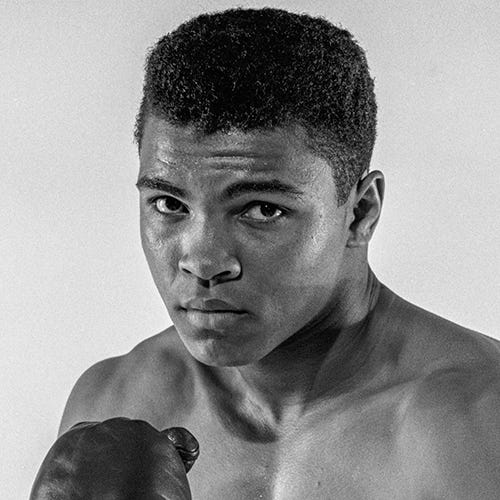
We may earn commission from links on this page, but we only recommend products we back.

Quick Facts
Olympic gold, relationship with malcolm x and conversion to islam, vietnam war protest and supreme court case, muhammad ali’s boxing record, wives, children, and family boxing legacy, parkinson’s diagnosis, philanthropy, muhammad ali center, declining health and death, funeral and memorial service, movies about muhammad ali, who was muhammad ali.
Muhammad Ali was a boxer, philanthropist, and social activist who is universally regarded as one of the greatest athletes of the 20th century. Ali became an Olympic gold medalist in 1960 and the world heavyweight boxing champion in 1964. Following his suspension for refusing military service in the Vietnam War, Ali reclaimed the heavyweight title two more times during the 1970s, winning famed bouts against Joe Frazier and George Foreman along the way. Ali retired from boxing in 1981 and devoted much of his time after to philanthropy. He earned the Presidential Medal of Freedom in 2005.
FULL NAME: Cassius Marcellus Clay Jr. BORN: January 17, 1942 DIED: June 3, 2016 BIRTHPLACE: Louisville, Kentucky SPOUSES: Sonji Roi (1964-1965), Belinda Boyd (1967-1977), Veronica Porché (1977-1986), and Yolanda Williams (1986-2016) CHILDREN: Maryum, Jamillah, Rasheda, Muhammad Jr., Miya, Khaliah, Hana, Laila Ali , and Asaad ASTROLOGICAL SIGN: Capricorn
Muhammad Ali was born on January 17, 1942, in Louisville, Kentucky. His birth name was Cassius Marcellus Clay Jr.
At an early age, young Clay showed that he wasn’t afraid of any bout—inside or outside of the ring. Growing up in the segregated South, he experienced racial prejudice and discrimination firsthand.
At the age of 12, Clay discovered his talent for boxing through an odd twist of fate. After his bike was stolen, Clay told police officer Joe Martin that he wanted to beat up the thief. “Well, you better learn how to fight before you start challenging people,” Martin reportedly told him at the time. In addition to being a police officer, Martin also trained young boxers at a local gym.
Clay started working with Martin to learn how to spar and soon began his boxing career. In his first amateur bout in 1954, he won the fight by split decision. Clay went on to win the 1956 Golden Gloves tournament for novices in the light heavyweight class. Three years later, he won the National Golden Gloves Tournament of Champions, as well as the Amateur Athletic Union’s national title for the light heavyweight division.
Clay attended mostly Black public schools, including Central High School in Louisville from 1956 to 1960. Clay often daydreamed in class and shadowboxed in the halls—he was training for the 1960 Olympics at the time—and his grades were so bad that some of his teachers wanted to hold him back from graduation. However, the school’s principal Atwood Wilson could see Clay’s potential and opposed this, sarcastically asking the staff, “Do you think I’m going to be the principal of a school that Cassius Clay didn’t finish?”
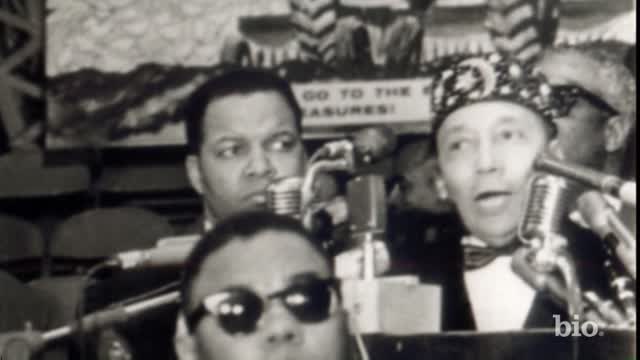
In 1960, Clay won a spot on the U.S. Olympic boxing team and traveled to Rome to compete. At 6 feet, 3 inches tall, Clay was an imposing figure in the ring, but he also became known for his lightning speed and fancy footwork. After winning his first three bouts, Clay defeated Zbigniew Pietrzkowski of Poland to win the light heavyweight Olympic gold medal.
After his Olympic victory, Clay was heralded as an American hero. He soon turned professional with the backing of the Louisville Sponsoring Group and continued overwhelming all opponents in the ring.
Clay met charismatic Nation of Islam minister Malcolm X at a rally in Detroit in June 1962. Floored by Malcolm X’s fearlessness as an orator, the two developed a friendship and Clay became more involved in the Black Muslim group. Malcolm X even assigned an associate to help manage Clay’s day-to-day affairs.
In 1964, Malcolm X brought his family to visit Clay while he trained in Florida for his February 25 title fight against Sonny Liston . Clay’s victory over Liston earned him his first world heavyweight boxing championship. Following the win, the two held an evening of reflection in a hotel room with Jim Brown and Sam Cooke that became the inspiration for the One Night in Miami stage play and 2020 drama film.
The next morning, on February 26, Clay announced his affiliation with the Nation of Islam. At first, he called himself Cassius X before settling on the name Muhammad Ali. Surprisingly, his allegiances were with supreme leader Elijah Muhammad and not the exiled Malcolm X. Ali and Malcolm’s friendship quickly fractured, and the two went their separate ways by that spring.
Ali showed little remorse upon Malcolm X’s murder on February 21, 1965, but admitted in his 2005 memoir Soul of a Butterfly : “Turning my back on Malcolm was one of the mistakes that I regret most in my life.”
The boxer eventually converted to orthodox Islam during the 1970s.
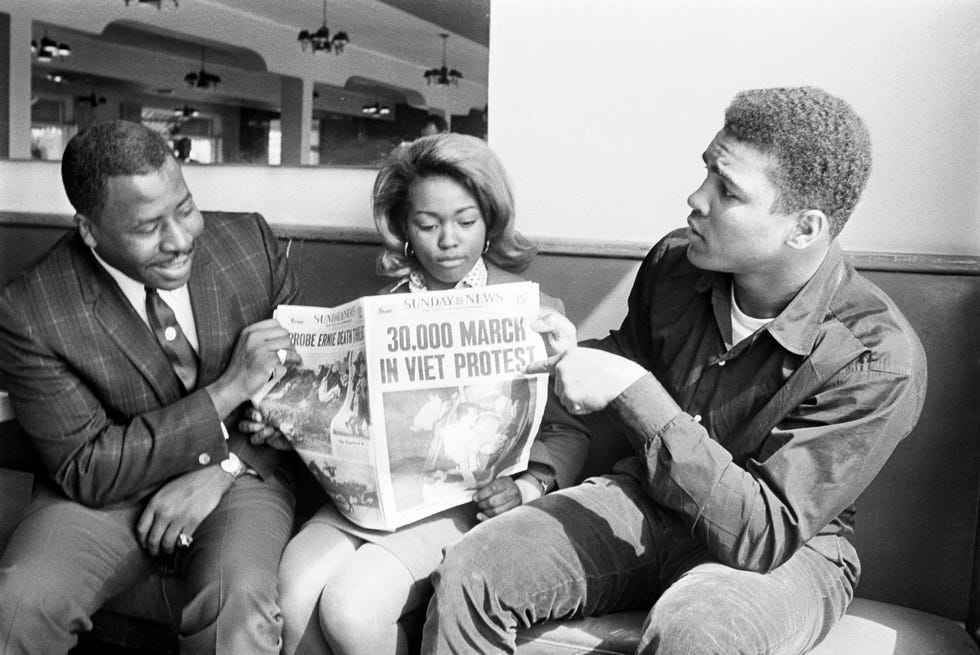
Ali started a different kind of fight with his outspoken views against the Vietnam War. Drafted into the military in April 1967, he refused to serve on the grounds that he was a practicing Muslim minister with religious beliefs that prevented him from fighting. He was arrested for committing a felony and almost immediately stripped of his world title and boxing license.
The U.S. Justice Department pursued a legal case against Ali and denied his claim for conscientious objector status. He was found guilty of violating Selective Service laws and sentenced to five years in prison in June 1967 but remained free while appealing his conviction.
Unable to compete professionally in the meantime, Ali missed more than three prime years of his athletic career. Following his suspension, Ali found refuge on Chicago’s South Side, where he lived from the mid-1960s through the late 1970s. He continued training, formed amateur boxing leagues, and fought whomever he could in local gyms.
Finally granted a license to fight in 1970 in Georgia, which did not have a statewide athletic commission, Ali returned to the ring at Atlanta’s City Auditorium on October 26 with a win over Jerry Quarry. A few months later, the U.S. Supreme Court overturned his conviction in June 1971, allowing Ali to fight on a regular basis.
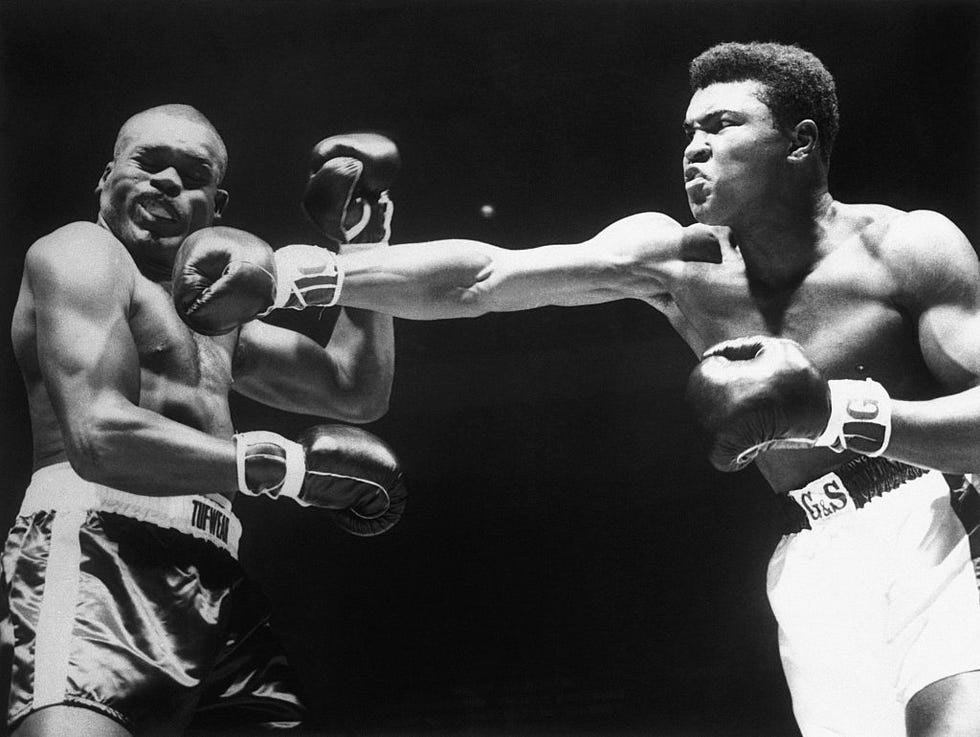
Ali had a career record of 56 wins, five losses, and 37 knockouts before his retirement in 1981 at the age of 39.
Often referring to himself as “The Greatest,” Ali was not afraid to sing his own praises. He was known for boasting about his skills before a fight and for his colorful descriptions and phrases. In one of his more famously quoted descriptions, Ali told reporters that he could “float like a butterfly, sting like a bee” in the boxing ring.
A few of his more well-known bouts include the following:
Sonny Liston
After winning gold at the 1960 Olympics, Ali took out British heavyweight champion Henry Cooper in 1963. He then knocked out Sonny Liston on February 25, 1964, to become the heavyweight champion of the world.
Joe Frazier
On March 8, 1971, Ali took on Joe Frazier in what has been called the “Fight of the Century.” Frazier and Ali went toe-to-toe for 14 rounds before Frazier dropped Ali with a vicious left hook in the 15th. Ali recovered quickly, but the judges awarded the decision to Frazier, handing Ali his first professional loss after 31 wins.
After suffering a loss to Ken Norton, Ali beat Frazier in a rematch on January 28, 1974.
In 1975, Ali and Frazier locked horns again for their grudge match on October 1 in Quezon City, Philippines. Dubbed the “Thrilla in Manila,” the bout nearly went the distance, with both men delivering and absorbing tremendous punishment. However, Frazier’s trainer threw in the towel after the 14th round, giving the hard-fought victory to Ali.
George Foreman
Another legendary Ali fight took place on October 30, 1974, against undefeated heavyweight champion George Foreman . Billed as the “Rumble in the Jungle,” the bout was organized by promoter Don King and held in Kinshasa, Zaire.
For once, Ali was seen as the underdog to the younger, massive Foreman, but he silenced his critics with a masterful performance. He baited Foreman into throwing wild punches with his “rope-a-dope” technique, before stunning his opponent with an eighth-round knockout to reclaim the heavyweight title.
Leon Spinks
After losing his title to Leon Spinks on February 15, 1978, Ali defeated him months later in a rematch on September 15. Ali became the first boxer to win the heavyweight championship three times.
Larry Holmes
Following a brief retirement, Ali returned to the ring to face Larry Holmes on October 2, 1980, but was overmatched against the younger champion.
Following one final loss in 1981, to Trevor Berbick, the boxing great retired from the sport at age 39.
Ali was married four times and had nine children, including two children—daughters Miya and Khaliah—he fathered outside of marriage.
Ali married his first wife, Sonji Roi, in 1964. They divorced a little more than one year later when she refused to adopt the Nation of Islam dress and customs.
Ali married his second wife, 17-year-old Belinda Boyd, in 1967. Boyd and Ali had four children together: Maryum, born in 1969; Jamillah and Rasheda, both born in 1970; and Muhammad Ali Jr., born in 1972. Boyd and Ali’s divorce was finalized in 1977.
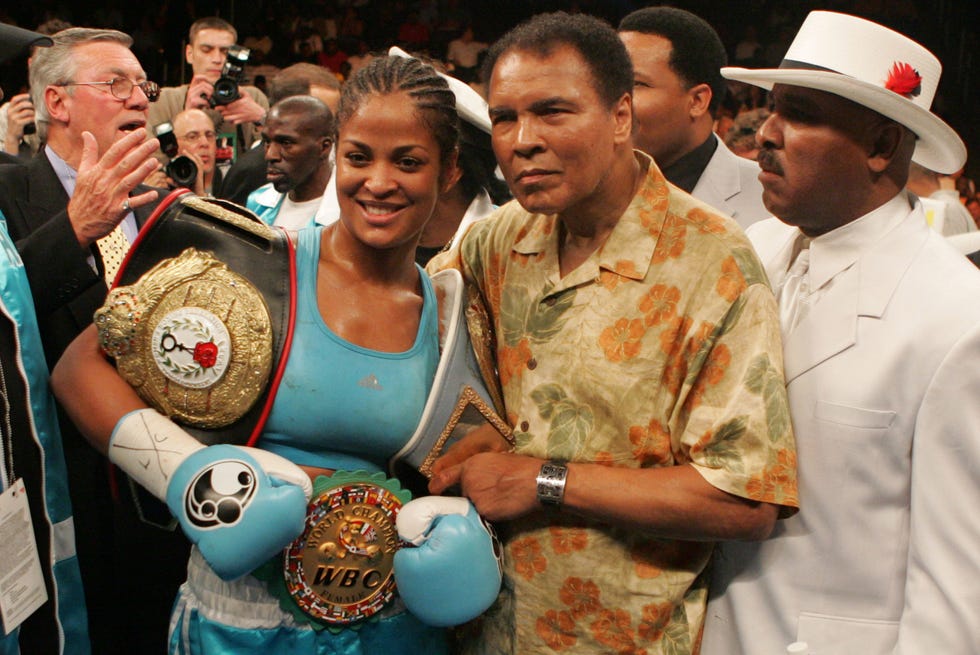
At the same time Ali was married to Boyd, he traveled openly with Veronica Porché, who became his third wife in 1977. The pair had two daughters together, Hana and Laila Ali . The latter followed in Ali’s footsteps by becoming a champion boxer. Porché and Ali divorced in 1986.
Ali married his fourth and final wife Yolanda, who went by Lonnie, in 1986. The pair had known each other since Lonnie was just 6 and Ali was 21; their mothers were best friends and raised their families on the same street. Ali and Lonnie had one son together, Asaad, and remained married until Ali’s death.
Grandchildren
Rasheda’s son Nico Walsh Ali became a boxer like his grandfather and aunt. In 2021, he signed a deal with legendary Top Rank promoter Bob Arum, who promoted 27 of Muhammad Ali’s bouts. He won his first eight professional fights, according to database BoxRec.
Nico’s brother, Biaggio Ali Walsh, was a star football running back, helping lead national powerhouse Bishop Gorman High School in Las Vegas to the top of the USA Today rankings from 2014 through 2016. He played collegiately at the University of California, Berkeley and the University of Nevada, Las Vegas before becoming an amateur mixed martial artist.
The brothers have drawn the attention of social media celebrity Jake Paul, a novice boxer who has said he’d like to fight both and “erase” them.
One of Ali’s other grandsons, Jacob Ali-Wertheimer, competed in NCAA track and field at Harvard University and graduated in 2021.
In 1984, Ali announced that he had Parkinson’s disease, a degenerative neurological condition. Despite the progression of Parkinson’s and the onset of spinal stenosis, he remained active in public life.
Ali raised funds for the Muhammad Ali Parkinson Center in Phoenix, Arizona. And he was on hand to celebrate the inauguration of the first Black president in January 2009, when Barack Obama was sworn into office.
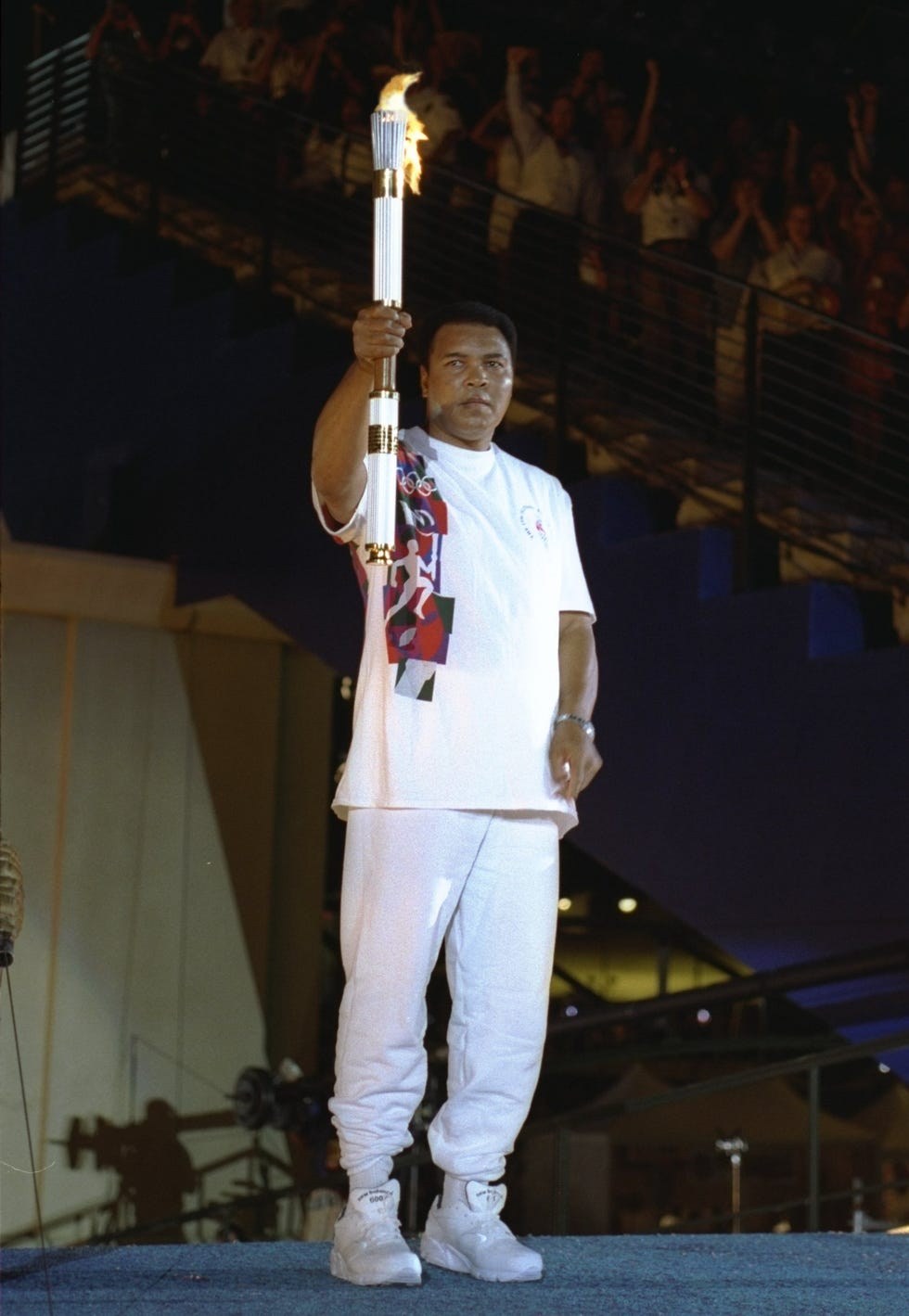
In his retirement, Ali devoted much of his time to philanthropy. Over the years, Ali supported the Special Olympics and the Make-A-Wish Foundation, among other organizations. In 1996, he lit the Olympic cauldron at the Summer Olympic Games in Atlanta, an emotional moment in sports history.
Ali traveled to numerous countries, including Mexico and Morocco, to help out those in need. In 1998, he was chosen to be a United Nations Messenger of Peace because of his work in developing nations.
In 2005, Ali received the Presidential Medal of Freedom from President George W. Bush .
Ali also received the President’s Award from the NAACP in 2009 for his public service efforts. Other recipients of the award have included include Ella Fitzgerald , Venus and Serena Williams , Kerry Washington , Spike Lee , John Legend , Rihanna , and LeBron James .
Ali opened the Muhammad Ali Center , a multicultural center with a museum dedicated to his life and legacy, in his hometown of Louisville in 2005.
“I am an ordinary man who worked hard to develop the talent I was given,” he said. “Many fans wanted to build a museum to acknowledge my achievements. I wanted more than a building to house my memorabilia. I wanted a place that would inspire people to be the best that they could be at whatever they chose to do, and to encourage them to be respectful of one another.”
Ali lived the final decade of his live in the Phoenix suburb of Paradise Valley, Arizona.
A few years before his death, Ali underwent surgery for spinal stenosis, a condition causing the narrowing of the spine, which limited his mobility and ability to communicate. In early 2015, he battled pneumonia and was hospitalized for a severe urinary tract infection.
Ali died on June 3, 2016, in Scottsdale, Arizona, after being hospitalized for what was reportedly a respiratory issue. He was 74 years old.
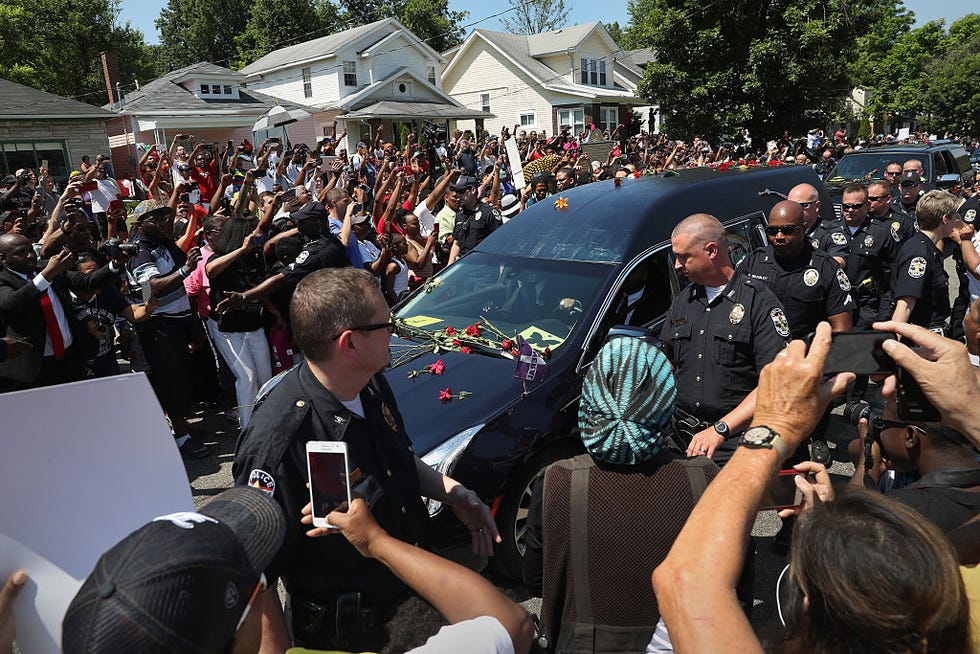
Years before his passing, Ali had planned his own memorial services, saying he wanted to be “inclusive of everyone, where we give as many people an opportunity that want to pay their respects to me,” according to a family spokesman.
The three-day event, which took place in Ali’s hometown of Louisville, included an “I Am Ali” public arts festival, entertainment and educational offerings sponsored by the city, an Islamic prayer program, and a memorial service.
Prior to the memorial service, a funeral procession traveled 20 miles through Louisville, past Ali’s childhood home, his high school, the first boxing gym where he trained, and along Ali Boulevard as tens of thousands of fans tossed flowers on his hearse and cheered his name.
The champ’s memorial service was held at the KFC Yum Center arena with close to 20,000 people in attendance. Speakers included religious leaders from various faiths: Attallah Shabazz, Malcolm X’s eldest daughter; broadcaster Bryant Gumbel; former President Bill Clinton ; comedian Billy Crystal; Ali’s daughters Maryum and Rasheda; and his widow, Lonnie.
“Muhammad indicated that when the end came for him, he wanted us to use his life and his death as a teaching moment for young people, for his country, and for the world,” Lonnie said. “In effect, he wanted us to remind people who are suffering that he had seen the face of injustice—that he grew up during segregation and that during his early life he was not free to be who he wanted to be. But he never became embittered enough to quit or to engage in violence.”
Clinton spoke about how Ali found self-empowerment: “I think he decided, before he could possibly have worked it all out, and before fate and time could work their will on him, he decided he would not ever be disempowered. He decided that not his race, nor his place, the expectations of others—positive, negative, or otherwise—would strip from him the power to write his own story.”
Crystal, who was a struggling comedian when he became friends with Ali, said of the boxing legend: “Ultimately, he became a silent messenger for peace, who taught us that life is best when you build bridges between people, not walls.”
Pallbearers included Will Smith , who once portrayed Ali on film, and former heavyweight champions Mike Tyson and Lennox Lewis. Ali is buried at the Cave Hill National Cemetery in Louisville.
Ali’s stature as a legend continues to grow even after his death. He is celebrated not only for his remarkable athletic skills but for his willingness to speak his mind and his courage to challenge the status quo.
Ali played himself in the 1977 film The Greatest , which explored parts of his life such as his rise to boxing fame, conversion to Islam, and refusal to serve in Vietnam.
The 1996 documentary When We Were Kings explores Ali’s training process for his 1974 fight against George Foreman and the African political climate at the time. Directed by Leon Gast, the film won an Academy Award for Best Documentary Feature.
Actor Will Smith played Ali in the biopic film Ali, released in 2001. For the performance, Smith received an Academy Award nomination for Best Actor.
Ali’s relationship with Malcolm X is explored in the fictionalized 2020 drama One Night in Miami and the 2021 documentary Blood Brothers: Malcolm X and Muhammad Ali .
- The man who views the world at 50 the same as he did at 20 has wasted 30 years of his life.
- It isn’t the mountains ahead to climb that wear you out; it’s the pebble in your shoe.
- I’m gonna float like a butterfly, sting like a bee. The hands can’t hit what the eyes can’t see.
- I am an ordinary man who worked hard to develop the talent I was given.
- I’m the champion of the world. I’m the greatest thing that ever lived. I’m so great I don’t have a mark on my face. I shook up the world! I shook up the world!
- If Clay says a mosquito can pull a plow, don’t ask how—Hitch him up!
- You get the impression while watching him fight that he plays cat and mouse, then turns out the light.
- The real enemy of my people is here. I will not disgrace my religion, my people, or myself by becoming a tool to enslave those who are fighting for their own justice, freedom, and equality.
- Religions all have different names, but they all contain the same truths. I think the people of our religion should be tolerant and understand people believe different things.
- It’s just a job. Grass grows, birds fly, waves pound the sand. I beat people up.
- I set out on a journey of love, seeking truth, peace, and understanding. l am still learning.
- Truly great people in history never wanted to be great for themselves.
- At night when I go to bed, I ask myself, “If I don’t wake up tomorrow, would I be proud of how I lived today?”
- This is the story about a man with iron fists and a beautiful tan.
Fact Check: We strive for accuracy and fairness. If you see something that doesn’t look right, contact us !
The Biography.com staff is a team of people-obsessed and news-hungry editors with decades of collective experience. We have worked as daily newspaper reporters, major national magazine editors, and as editors-in-chief of regional media publications. Among our ranks are book authors and award-winning journalists. Our staff also works with freelance writers, researchers, and other contributors to produce the smart, compelling profiles and articles you see on our site. To meet the team, visit our About Us page: https://www.biography.com/about/a43602329/about-us
Tyler Piccotti first joined the Biography.com staff as an Associate News Editor in February 2023, and before that worked almost eight years as a newspaper reporter and copy editor. He is a graduate of Syracuse University. When he's not writing and researching his next story, you can find him at the nearest amusement park, catching the latest movie, or cheering on his favorite sports teams.
Famous Athletes
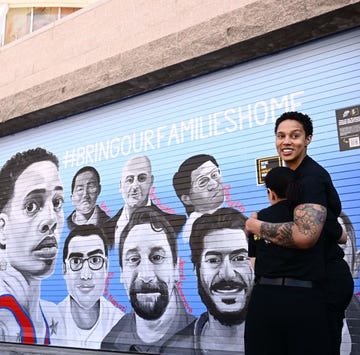
Simone Biles

Trinity Rodman

Dorothy Hamill
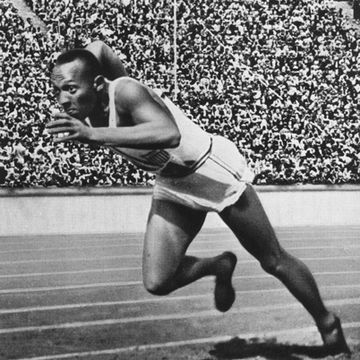
Jesse Owens

Alice Coachman

Wilma Rudolph

Tiger Woods

Caitlin Clark Prepares to Join the WNBA
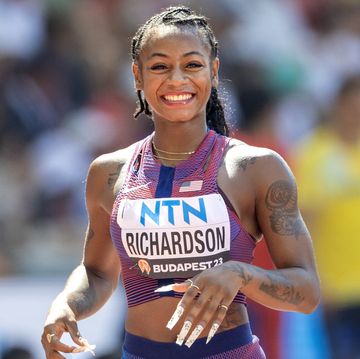
Sha’Carri Richardson

Aaron Rodgers
- History Classics
- Your Profile
- Find History on Facebook (Opens in a new window)
- Find History on Twitter (Opens in a new window)
- Find History on YouTube (Opens in a new window)
- Find History on Instagram (Opens in a new window)
- Find History on TikTok (Opens in a new window)
- This Day In History
- History Podcasts
- History Vault
Muhammad Ali
By: History.com Editors
Updated: February 27, 2024 | Original: December 16, 2009

Muhammad Ali (1942-2016) was an American former heavyweight champion boxer and one of the greatest sporting figures of the 20th century. An Olympic gold medalist and the first fighter to capture the heavyweight title three times, Ali won 56 times in his 21-year professional career. Ali’s outspokenness on issues of race, religion and politics made him a controversial figure during his career, and the heavyweight’s quips and taunts were as quick as his fists.
Born Cassius Clay Jr., Ali changed his name in 1964 after joining the Nation of Islam. Citing his religious beliefs, he refused military induction and was stripped of his heavyweight championship and banned from boxing for three years during the prime of his career. Parkinson’s syndrome severely impaired Ali’s motor skills and speech, but he remained active as a humanitarian and goodwill ambassador.
Muhammad Ali’s Early Years and Amateur Career
Cassius Marcellus Clay Jr., the elder son of Cassius Marcellus Clay Sr. (1912-1990) and Odessa Grady Clay (1917-1994), was born on January 17, 1942, in Louisville, Kentucky . It was a red-and-white Schwinn that steered the future heavyweight champion to the sport of boxing. When his beloved bicycle was stolen, a tearful 12-year-old Clay reported the theft to Louisville police officer Joe Martin (1916-1996) and vowed to pummel the culprit. Martin, who was also a boxing trainer, suggested that the upset youngster first learn how to fight, and he took Clay under his wing. Six weeks later, Clay won his first bout in a split decision.
Did you know? Muhammad Ali has appeared on the cover of Sports Illustrated 38 times, second only to basketball great Michael Jordan.
By age 18 Clay had captured two national Golden Gloves titles, two Amateur Athletic Union national titles and 100 victories against eight losses. After graduating high school, he traveled to Rome and won the light heavyweight gold medal in the 1960 Summer Olympics.
Clay won his professional boxing debut on October 29, 1960, in a six-round decision. From the start of his pro career, the 6-foot-3-inch heavyweight overwhelmed his opponents with a combination of quick, powerful jabs and foot speed, and his constant braggadocio and self-promotion earned him the nickname “Louisville Lip.”
Muhammad Ali: Heavyweight Champion of the World
After winning his first 19 fights, including 15 knockouts, Clay received his first title shot on February 25, 1964, against reigning heavyweight champion Sonny Liston (1932-1970). Although he arrived in Miami Beach, Florida, a 7-1 underdog, the 22-year-old Clay relentlessly taunted Liston before the fight, promising to “float like a butterfly, sting like a bee” and predicting a knockout. When Liston failed to answer the bell at the start of the seventh round, Clay was indeed crowned heavyweight champion of the world. In the ring after the fight, the new champ roared, “I am the greatest!”
At a press conference the next morning, Clay, who had been seen around Miami with controversial Nation of Islam member Malcolm X (1925-1965), confirmed the rumors of his conversion to Islam. On March 6, 1964, Nation of Islam leader Elijah Muhammad (1897-1975) bestowed on Clay the name of Muhammad Ali.
Ali solidified his hold on the heavyweight championship by knocking out Liston in the first round of their rematch on May 25, 1965, and he defended his title eight more times. Then, with the Vietnam War raging, Ali showed up for his scheduled induction into the U.S. Armed Forces on April 28, 1967. Citing his religious beliefs, he refused to serve. Ali was arrested, and the New York State Athletic Commission immediately suspended his boxing license and revoked his heavyweight belt.
Convicted of draft evasion, Ali was sentenced to the maximum of five years in prison and a $10,000 fine, but he remained free while the conviction was appealed. Many saw Ali as a draft dodger, and his popularity plummeted. Banned from boxing for three years, Ali spoke out against the Vietnam War on college campuses. As public attitudes turned against the war, support for Ali grew. In 1970 the New York State Supreme Court ordered his boxing license reinstated, and the following year the U.S. Supreme Court overturned his conviction in a unanimous decision.
Muhammad Ali’s Return to the Ring
After 43 months in exile, Ali returned to the ring on October 26, 1970, and knocked out Jerry Quarry (1945-1999) in the third round. On March 8, 1971, Ali got his chance to regain his heavyweight crown against reigning champ Joe Frazier (1944-2011) in what was billed as the “Fight of the Century.” The undefeated Frazier floored Ali with a hard left hook in the final round. Ali got up but lost in a unanimous decision, experiencing his first defeat as a pro.
Ali won his next 10 bouts before being defeated by Ken Norton (1943-). He won the rematch six months later in a split decision and gained further revenge in a unanimous decision over Frazier in a non-title rematch. The victory gave the 32-year-old Ali a title shot against 25-year-old champion George Foreman (1949-). The October 30, 1974, fight in Kinshasa, Zaire, was dubbed the “Rumble in the Jungle.” Ali, the decided underdog, employed his “rope-a-dope” strategy, leaning on the ring ropes and absorbing a barrage of blows from Foreman while waiting for his opponent to tire. The strategy worked, and Ali won in an eighth-round knockout to regain the title stripped from him seven years prior.
Ali successfully defended his title in 10 fights, including the memorable “Thrilla in Manila” on October 1, 1975, in which his bitter rival Frazier, his eyes swollen shut, was unable to answer the bell for the final round. Ali also defeated Norton in their third meeting in a unanimous 15-round decision.
On February 15, 1978, an aging Ali lost his title to Leon Spinks (1953-) in a 15-round split decision. Seven months later, Ali defeated Spinks in a unanimous 15-round decision to reclaim the heavyweight crown and become the first fighter to win the world heavyweight boxing title three times.
After announcing his retirement in 1979, Ali launched a brief, unsuccessful comeback. However, he was overwhelmed in a technical knockout loss to Larry Holmes (1949-) in 1980, and he dropped a unanimous 10-round decision to Trevor Berbick (1954-2006) on December 11, 1981. After the fight, the 39-year-old Ali retired for good with a career record of 56 wins, five losses and 37 knockouts.
Muhammad Ali’s Later Years and Legacy
In 1984 Ali was diagnosed with Parkinson’s syndrome, possibly connected to the severe head trauma suffered during his boxing career. The former champion’s motor skills slowly declined, and his movement and speech were limited. In spite of the Parkinson’s, Ali remained in the public spotlight, traveling the world to make humanitarian, goodwill and charitable appearances. He met with Iraqi leader Saddam Hussein (1937-2006) in 1990 to negotiate the release of American hostages, and in 2002 he traveled to Afghanistan as a United Nations Messenger of Peace.
Ali had the honor of lighting the cauldron during the opening ceremonies of the 1996 Summer Olympics in Atlanta. In 1999 Ali was voted the BBC’s “Sporting Personality of the Century,” and Sports Illustrated named him “Sportsman of the Century.” Ali was awarded the Presidential Medal of Freedom in a 2005 White House ceremony, and in the same year the $60 million Muhammad Ali Center, a nonprofit museum and cultural center focusing on peace and social responsibility, opened in Louisville.
Ring Magazine named Ali “Fighter of the Year” five times, more than any other boxer, and he was inducted into the International Boxing Hall of Fame in 1990. Ali has been married four times and has seven daughters and two sons. He married his fourth wife, Yolanda, in 1986. Ali died at the age of 74 on June 3, 2016.

Sign up for Inside History
Get HISTORY’s most fascinating stories delivered to your inbox three times a week.
By submitting your information, you agree to receive emails from HISTORY and A+E Networks. You can opt out at any time. You must be 16 years or older and a resident of the United States.
More details : Privacy Notice | Terms of Use | Contact Us
- Milano Cortina 2026
- Brisbane 2032
- Olympic Refuge Foundation
- Olympic Games
- Olympic Channel
- Let's Move
Stolen cycle to Olympics gold: origin of the Muhammad Ali legend
Victory for Muhammad Ali, then called Cassius Clay, at Rome 1960 put the American boxer on the path to be 'The Greatest'.
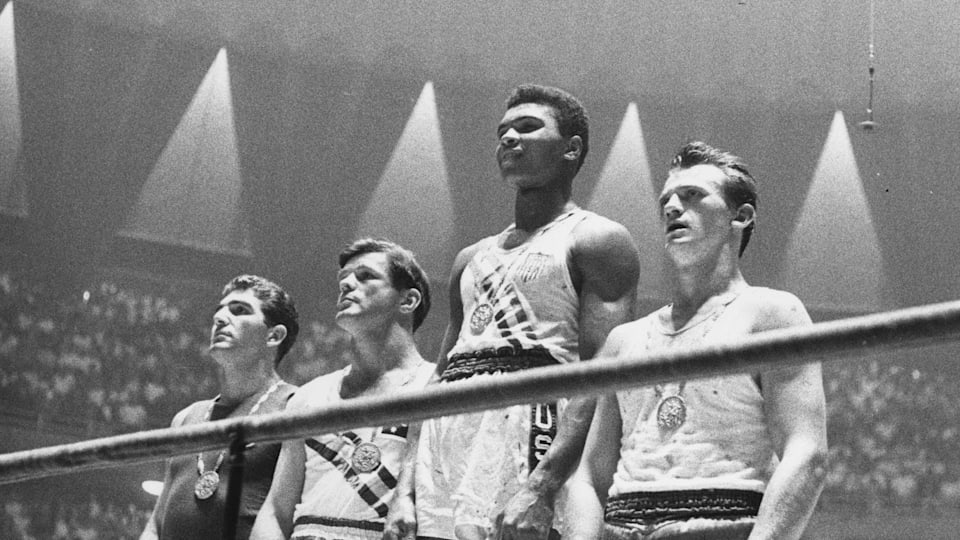
It all begins with a stolen bike.
When a 12-year-old Muhammad Ali , then known as Cassius Clay , went to a fair at the Columbia Gym in his hometown of Louisville back in 1955, his pride and joy - a red and white Schwinn bicycle - went missing.
Having quickly gone from two wheels to no wheels, the boy Ali was incandescent with rage, promising to "whoop" the thief if he ever laid hands on him.
Muhammad Ali’s angry outburst caught the attention of a local police officer, Joe Martin, who invited him to channel his fury by taking boxing classes at his gym.
The rest, as they say, is history. From that chance encounter, a legend was born.
Within six weeks, Ali had won his first fight.
Within six years, Muhammad Ali had a gold medal hanging around his neck at the Olympic Games in Rome.

‘Turbulent’ journey to Rome 1960
Muhammad Ali traveled to the Rome 1960 Olympics to represent the United States as a callow, relatively unknown 18-year-old.
In fact, the then-light heavyweight nearly didn't travel to Italy at all.
A turbulent flight to California for the Olympic trials had put Ali off flying.
Only after some more gentle encouragement from his mentor, Joe Martin, was Ali persuaded to get on the plane.
Reputedly, the teenage boxer did insist on taking a parachute on board for the journey - just in case.
Muhammad Ali’s Olympic medal
As befitting a man nicknamed 'the Louisville Lip', Muhammad Ali soon began making his presence felt around the Olympic village, becoming a hugely popular figure.
But as well as making friends outside the ring, Ali began making an impression inside it too.
In his first bout at the Rome Olympics against Belgian Yvon Becaus, the referee had to stop the contest in the second round, fearing a brutal knockout.
His quarter-final opponent was Russia's Gennady Shatkov, a man who had won Olympic gold in the middleweight division four years earlier.
Despite his impressive pedigree, he was no match for the American - who swept to a 5-0 triumph on points.
That scoreline was replicated in his next bout against Australia’s star pugilist Tony Madigan. Although Muhammad Ali had to dig deep at times, he had made it through to the light heavyweight Olympic final.
Standing in the opposite corner to Muhammad Ali in Rome’s Palazzo dello Sport stadium on September 5, 1960, was the imposing frame of Poland's Zbigniew Pietrzykowski.
Pietrzykowski was stronger and vastly more experienced than his rival, and Ali initially struggled to adapt to his rival's southpaw style.
The 25-year-old Pole edged the first two rounds, but in the final round, Muhammad Ali came to the fore.
With his superior stamina and quick combinations, the American left his rival in a battered - but still upright - state by the final bell. The judges were unanimous once again. Olympic gold was his.
Muhammad Ali: Olympic champion
Muhammad Ali's joy was unconfined after his triumph, telling reporters about what being an Olympic champion meant:
"I didn’t take that medal off for 48 hours. I even wore it to bed. I didn’t sleep too good because I had to sleep on my back so that the medal wouldn’t cut me. But I didn’t care, I was Olympic champion."
Ali's rapid, shuffling style had not always found favour amongst boxing 'purists', but there was now no denying his quality.
Much like his painter-musician father Cassius Marcellus Clay Sr., whom Ali dubbed ‘the fanciest dancer of Louisville’, the ace boxer could ‘float like a butterfly’. But his dance floor was the boxing ring.
The fact that he ‘stung like a bee’ with his rapid punches, made him a nightmare for opponents and a dream to watch for millions of boxing fans all around the world.
Soon after his return to America, Muhammad Ali turned professional and made his debut against Tunney Hunsaker on October 29th, 1960.
The journey to becoming 'The Greatest' was well and truly underway.
Championing the Olympic spirit
At the age of 22, Cassius Clay Jr. became Muhammad Ali after converting to Islam and changing his name.
A staunch critic of the Vietnam War, Ali stuck to his guns, or rather shunned them, and refused to be inducted into the armed forces. It was a move that came at a huge personal cost, denying him the opportunity to box for nearly four years in the prime of his career.
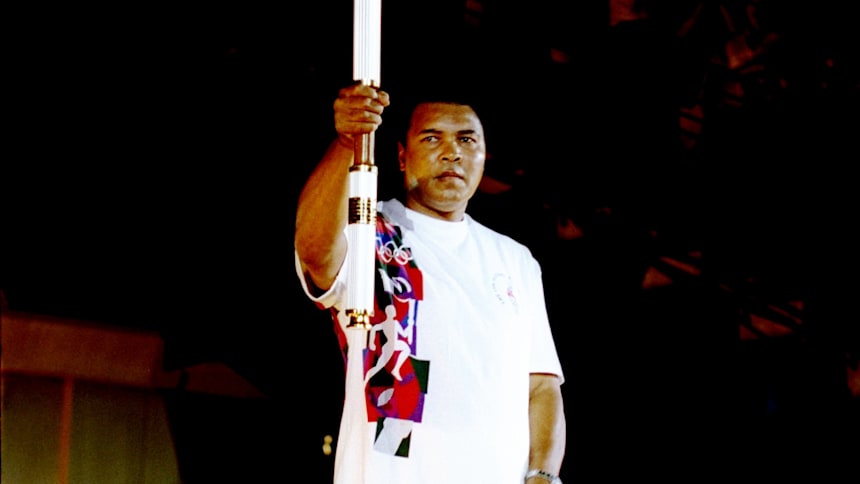
Even after being diagnosed with Parkinson’s disease, Ali traveled all around the world spreading the message of peace and brotherhood, representing the true spirit of the Olympic movement.
He returned on the Olympic stage at the Atlanta 1996 Olympics as the final torch-bearer, who lit the Olympic flame for that edition.
At London 2012 - four years before his death - Ali escorted the Olympic Flag to the stadium for the opening ceremony.
Like the eternal Olympic flame, his legend continues to burn bright and proud.
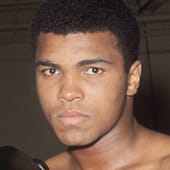
Related content

From Felix Savon to Mary Kom, world champions who ruled the boxing ring

Explained: Two bronze medals are awarded in the Olympics boxing competition
You may like.
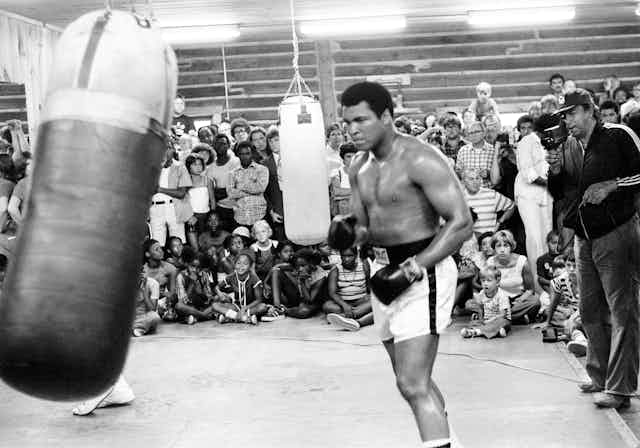
What made Muhammad Ali ‘The Greatest’ in the ring?
Adjunct Professor, University of Canberra
Disclosure statement
Allan Hahn does not work for, consult, own shares in or receive funding from any company or organisation that would benefit from this article, and has disclosed no relevant affiliations beyond their academic appointment.
University of Canberra provides funding as a member of The Conversation AU.
View all partners
Many factors came together to create recognition of Muhammad Ali, who has died aged 74, as “the greatest” boxer in history.
There is no doubt Ali’s determination to overcome racial inequality , his refusal to fight in the Vietnam War, his emergence as a representative of Islam and his highly engaging media persona coalesced to make him by far the most widely known boxer of all time. He came to be popularly regarded as a champion of the oppressed and a seeker of justice for the persecuted. This resonated globally.
Central to the celebrity Ali achieved, though, was his exceptional ability as a boxer.
A unique style
Various boxing authorities have ranked Ali as the best heavyweight boxer in history. He and the legendary Sugar Ray Robinson have been bracketed as the top two across all weight divisions.
Ali won a gold medal (as a light heavyweight) at the 1960 Rome Olympics as the culmination of an amateur boxing career in which he won 100 of 105 bouts.
As a professional, Ali won the world heavyweight championship on three separate occasions over 14 years. He was victorious in 56 of 61 professional bouts , with three of the losses coming late in his career when his athleticism had faded. Sports Illustrated named him as its Sportsman of the 20th Century.
What made Ali such an outstanding exponent of his sport?
It certainly wasn’t sheer strength and power. He was never considered to be among boxing’s hardest punchers and more than one-third of his professional contests lasted their full scheduled duration. Nor was he remarkable in terms of height or weight.
Rather, Ali’s speed, agility, footwork and general athleticism were among the attributes that most distinguished him from other competitors. It was said he was a heavyweight who moved like a lightweight .
In the early years of his career, Ali also displayed outstanding aerobic endurance: he was able to relentlessly maintain his dancing, up-on-the-toes style.
There is no doubt Ali was uniquely skilled. But he employed techniques that, while clearly effective, were far from classical. In stark contrast to contemporary views of best practice, he often held his hands by his sides at waist level, and he sometimes avoided the punches of opponents by pulling his head backwards away from them.
Many boxing experts regarded these as high-risk behaviours made viable only by Ali’s astonishing speed, but the unorthodoxy served to confuse his adversaries and lure them into errors. He was seldom the aggressor, preferring a method that capitalised on the aggression of others.
Ali very aptly characterised his own style as “float like a butterfly, sting like a bee”. His distinctive, unconventional boxing style was in keeping with the fierce individualism and rejection of norms that pervaded other aspects of his life and created almost universal interest in him.
Mental strength
Ali also demonstrated major psychological strengths. He was renowned for his self-belief, which frequently extended beyond vociferous pre-contest expressions of confidence to actually nominating the very round in which he would win.
He was predisposed to composing rap-style poems designed to extol his talents and unsettle opponents, and was well-known for his intimidatory stares and for subjecting opponents to verbal taunts during bouts.
Over time, Ali’s perennial competitive success seemed increasingly to justify the self-belief and enabled him to inculcate an impression that he was almost superhuman. That was an impression that a public seeking new heroes in turbulent social and political times was very willing to accept. In addition, it appears to have been embraced by Ali himself.
The self-belief and illusion of superhuman qualities were arguably instrumental in enabling Ali to get through a number of torturous contests. These included the “Thrilla in Manila”, where he and Joe Frazier inflicted shocking damage on each other in what he later described as a near-death experience, and the “Rumble in the Jungle”.
In the Rumble in the Jungle, Ali absorbed some massively forceful punches from George Foreman as part of a contrived “rope-a-dope” strategy . This eventually brought him an unlikely victory that proved to be the crowning glory of his incredible boxing journey.
In the phase of his boxing career commencing after his 3½-year suspension from the sport due to his refusal to enter the US Armed Forces, Ali became famous for an extraordinary ability to “take a punch”. This – along with the courage and commitment to purpose that it implies – has been viewed as another reason for his boxing greatness.
The taking of punches, though, very likely had a significant downside in causing neurological injury and contributing to the Parkinson’s disease that affected his life from the mid-1980s onwards and was soon greatly debilitating.
Ali not only competed during the “golden years of heavyweight boxing” but was the fundamental reason for them. He brought completely new dimensions to the sport and gave it a sort of aestheticism and a broader relevance that was without precedent.
Despite the health problems that he suffered in retirement, he reportedly continued to enjoy being Muhammad Ali. That enjoyment was well-earnt. He inspired and empowered multitudes of people around the world and engendered cultural change.
Ali’s passing has evoked widespread sadness, particularly among the many admirers who somehow identified so strongly with him that they felt a quite intensively personal sharing of his triumphs and defeats, both in the ring and outside it. He leaves an enduring and highly influential legacy, that in the final analysis has been made possible by the qualities that made him genuinely “the greatest” as a boxer.
Further reading:
Muhammad Ali rewrote the rule book for athletes as celebrities and activists
Final bell sounds for Muhammad Ali: The Greatest
- Sports science
- Muhammad Ali

Executive Dean, Faculty of Health

Events and Communications Coordinator

Assistant Editor - 1 year cadetship

Lecturer/Senior Lecturer, Earth System Science (School of Science)

Sydney Horizon Educators (Identified)
- Muhammad Ali
Exclusive: The Real Reason Muhammad Ali Converted to Islam
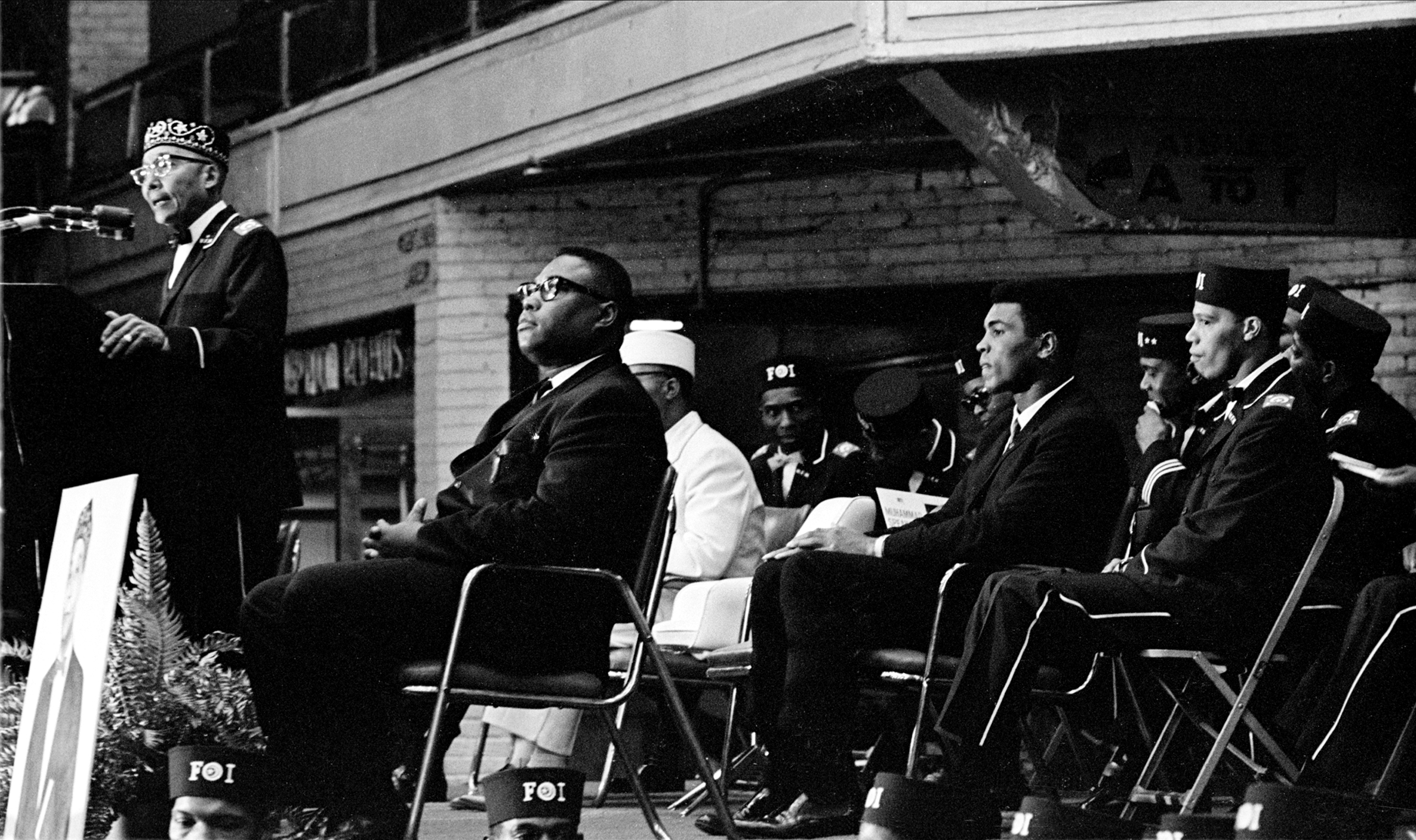
Muhammad Ali ‘s public conversion to Islam, in 1964, was among the most defining moments of his remarkable life . The decision enraged his critics — his hometown newspaper continued to refer to Ali by his birth name, Cassius Clay, for years to come — and led him to refuse to serve in Vietnam, a stand that cost him his title, his livelihood and, ultimately, cemented his status as an American iconoclast .
Ali, who died on June 3, 2016 at age 74 , has offered a few different reasons for his embrace of Islam. According to the 1967 book, Black Is Best: The Riddle of Cassius Clay , by former Sports Illustrated writer Jack Olsen, Ali said his first encounter came from a street corner proselytizer in Harlem. He later told Olsen that it came at a Nation of Islam meeting in Miami in 1960 or early 1961, and he also said that his first meeting was in Chicago.
Now there is another version of Ali’s story, which is arguably the most definitive of the bunch, appearing first in TIME.
In his forthcoming book Ali: A Life , out in October from Houghton Mifflin Harcourt, author Jonathan Eig excerpts a letter that Ali wrote to his second wife, Khalilah Camacho-Ali, who was married to the legendary fighter from 1967-1976. In the letter, which Camacho-Ali says her ex-husband wrote some time in the late 1960s, Ali describes seeing a cartoon in the Nation of Islam newspaper, Muhammad Speaks , outside a skating rink in his hometown of Louisville. The cartoon illustrated how white slave owners brutally beat their slaves, while insisting that they pray to Jesus. The message: Christianity was the religion of the oppressive white establishment. “I liked that cartoon,” Ali wrote. “It did something to me. And it made sense.”
You can see the letter below, as well as a transcription of its contents, lightly edited for clarity.

One night at a skating rink in Louisville (I was on my way home), the skating rink was located at 9th and Broadway St., while I was standing outside the building in a crowd of about 400 people, all black people, like most boys [I was looking] for a pretty girl to say something to. A black brother dressed in a black Mohair suit, [with a] white shirt and a black bowtie, was [selling] some newspapers called Muhammad Speaks. At that time it was the first time I had seen a Muhammad Speaks newspaper. The brother walked up to me and said, ‘my brother, do you want to buy a Muhammad Speaks newspaper, so that you can read about your own kind, read the real truth of your history, your true religion, your true name before you were [given] the White Man’s name in slavery?’ He said, ‘oh, by the way there is a meeting that we are having today on 27th and Chestnut St. at 8 o’clock this evening. And at the time it was about 6 o’clock in the evening. I told him OK, I will be there. But I had no intention to go to any meeting. But I did buy the Muhammad Speaks paper. And [one] thing in the paper [made] me keep the paper, and that was a cartoon. And the cartoon was about the first slaves that arrived in America, and the cartoon was showing how the black slaves were slipping off at the plantation to pray in the Arabic language facing the east. And the white slave master would run up behind the slave with a whip and hit the poor [slave] on the back with a whip and say, ‘what are you doing praying in that language, you know what I told you to speak,’ and the slave said, ‘yes sir, yes sir, Master. I will pray to Jesus, sir, Jesus.’ And I liked that cartoon. It did something to me. And it made sense.
Ali’s description of the cartoon matches a strip printed in the December 1961 edition of Muhammad Speaks , below.

Camacho-Ali asked Muhammad to write the letter after she confronted him about his extramarital dalliances. Explain, she instructed him, why you embraced Islam in the first place. “You might be big,” Camacho-Ali tells TIME. “But you’re not bigger than Allah. You’ve got to check yourself. There are consequences when you commit adultery.”
Eig says he paid Camacho-Ali $600 for the letter. “In all likelihood, Ali’s interest in the Nation Of Islam grew over time and repeated exposures,” Eig says. “The incident he describes in the letter—picking up the newspaper and reading the cartoon—may have been one in a series of influential events. But this is the only time we know of that he wrote the story of his indoctrination in his own words. That would seem to suggest, at the very least, that it was a key moment in his journey.”
Camacho-Ali sees the first anniversary of Ali’s passing as another chance to celebrate him, flaws and all. “Allah has opened the door for him in paradise,” she tells TIME. “He’s not suffering anymore. I cherish the good moments. There was more good than bad. It was a blessing to be a part of that journey.”
The Economic Times daily newspaper is available online now.
Muhammad ali: journey through the life and times of the legend.

Arguably the greatest sportsman of our times, Ali's whups inside the ring were matched only by his wit outside. Here’s a journey through the life and times of the legend.

Read More News on
Download The Economic Times News App to get Daily Market Updates & Live Business News.
Subscribe to The Economic Times Prime and read the ET ePaper online.

Satcom in India has two puzzles to solve before taking off

Tens of thousands of Indian gig workers are toiling at the frontiers of AI

No plane, no gain: How Go First became less attractive to bidders

Powders and bars are old foam, Indians are voting for liquid soaps

Ashneer Grover, BharatPe and the mystery of an out-of-court settlement

The crucial 20 metres at Vizhinjam promises to be a USD200 million opportunity for India.
Find this comment offensive?
Choose your reason below and click on the Report button. This will alert our moderators to take action
Reason for reporting:
Your Reason has been Reported to the admin.

To post this comment you must
Log In/Connect with:
Fill in your details:
Will be displayed
Will not be displayed
Share this Comment:
Uh-oh this is an exclusive story available for selected readers only..
Worry not. You’re just a step away.

Prime Account Detected!
It seems like you're already an ETPrime member with
Login using your ET Prime credentials to enjoy all member benefits
Log out of your current logged-in account and log in again using your ET Prime credentials to enjoy all member benefits.
To read full story, subscribe to ET Prime
₹34 per week
Billed annually at ₹2499 ₹1749
Super Saver Sale - Flat 30% Off
On ET Prime Membership
Unlock this story and enjoy all members-only benefits.
Offer Exclusively For You
Save up to Rs. 700/-
ON ET PRIME MEMBERSHIP
Get 1 Year Free
With 1 and 2-Year ET prime membership
Get Flat 40% Off
Then ₹ 1749 for 1 year
ET Prime at ₹ 49 for 1 month
Stay Ahead in the New Financial Year
Get flat 20% off on ETPrime
90 Days Prime access worth Rs999 unlocked for you

Exclusive Economic Times Stories, Editorials & Expert opinion across 20+ sectors
Stock analysis. Market Research. Industry Trends on 4000+ Stocks
Get 1 Year Complimentary Subscription of TOI+ worth Rs.799/-
Stories you might be interested in
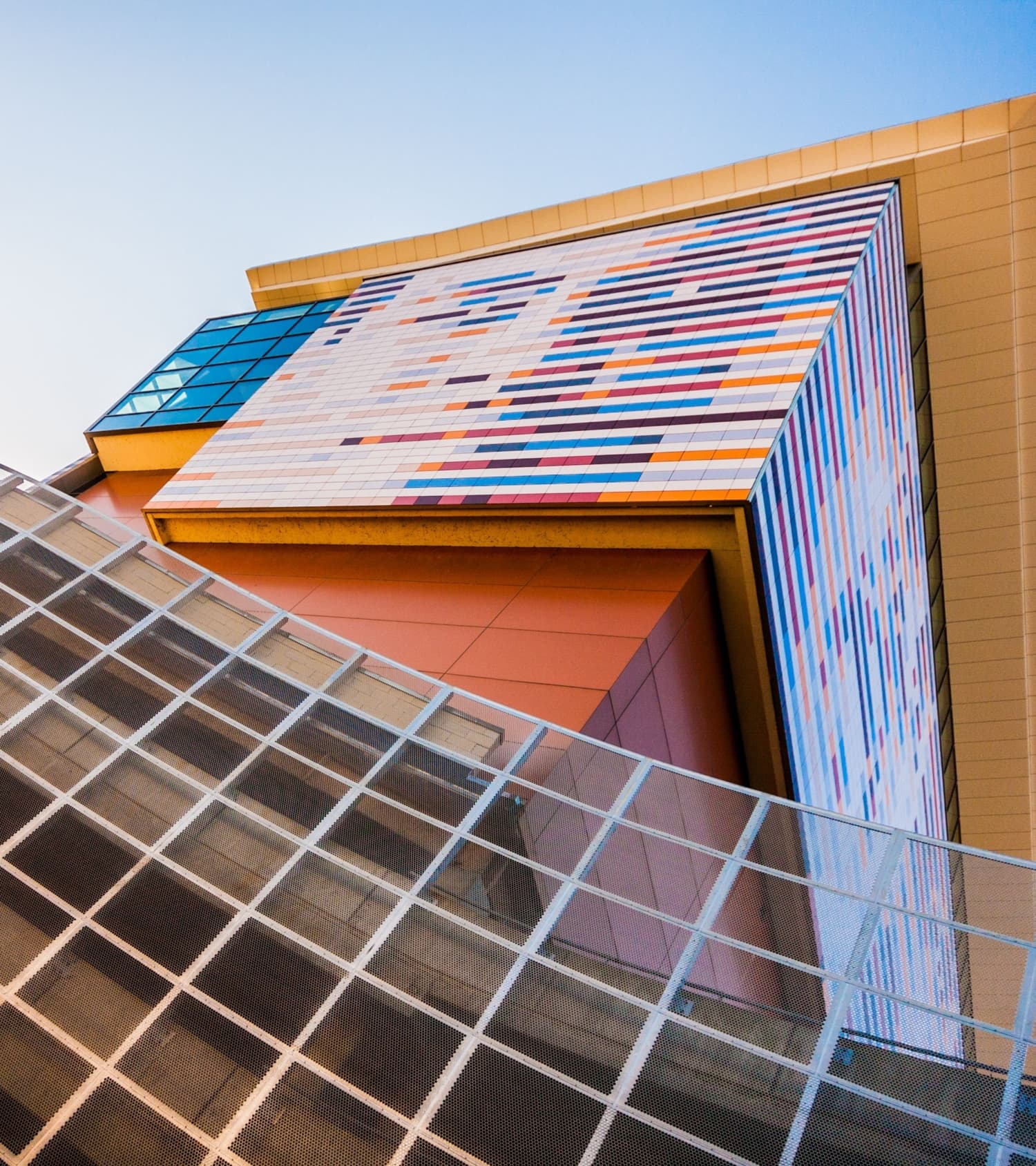
Meet the Greatest
Boxer, humanitarian, social activist: meet the people’s champion. explore the life of muhammad ali..
- Around the World
- Famous Friends
- Spirituality
- In His Corner
- The Timeline
- Boxing Timeline
- Humanitarian Timeline
Visit the Museum
The definitive muhammad ali experience. plan your visit, bring your group, shop in our retail store or host your event at the ali center..
- Ticket Prices
- Getting Here
- Groups and Field Trips
- Host an Event
At the Ali Center
The latest in greatness. what’s on at the ali center, from temporary and permanent exhibits to upcoming events., legacy in action, programs dedicated to mobilizing muhammad ali's legacy of promoting respect, inspiring change, and advancing social justice..
- Youth Leadership
- University Programming
- Community Engagement
- Learning Hub
- Collections and Archive
- DEIA Training
- Signature Annual Events
Support Greatness
Be a part of helping us inspire and celebrate the world’s changemakers through transformative experiences and training. here’s how..
- Corporate Support
- More Ways to Give
- Get Tickets
- In His Own Words
- Celebration of Life
- Six Core Principles
- Ali the Artist
Muhammad Ali was known to millions worldwide. His inner circle knew him the best.
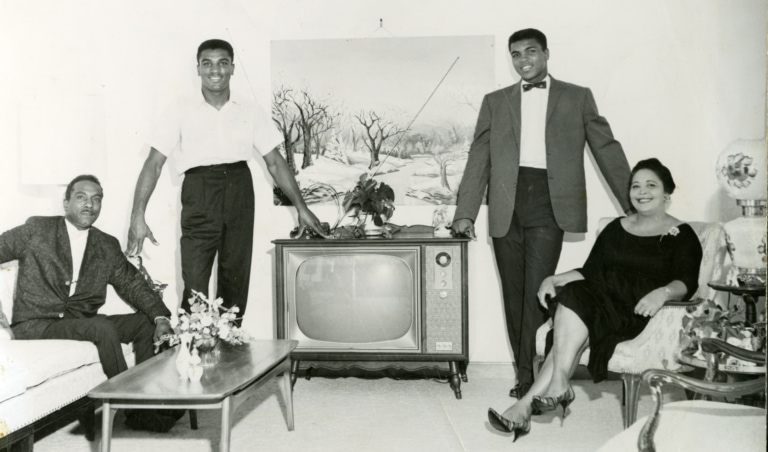
Ali's Inner Circle
The people who knew Muhammad Ali best and helped him become the People’s Champ.

One of the cornerstones of Muhammad Ali’s life was those in his corner, both in and out of the ring. Ali was a man who loved everyone and had friends everywhere he went, but the select few in his inner circle helped shape the fabric of his life.
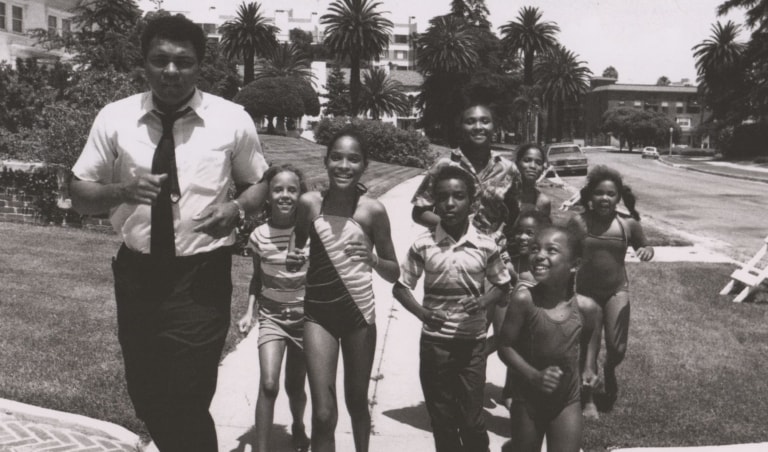
Ali’s father, Cassius Clay, Sr. and mother, Odessa Clay were large influences on his life. His mother played a big part in building up Ali’s spirituality and was a big supporter throughout his boxing career. Ali’s father worked as a painter and inspired Ali in the arts . Ali’s younger brother Rahaman was a lifetime companion.
Muhammad Ali had nine children: (from youngest to oldest) Asaad, Hana, Miya, Khalilah, Laila, Muhammad Ali Jr., Jamillah, Rasheeda and Maryum.
He married Lonnie Ali on November 19, 1986 at a small family ceremony in Louisville, Ky.
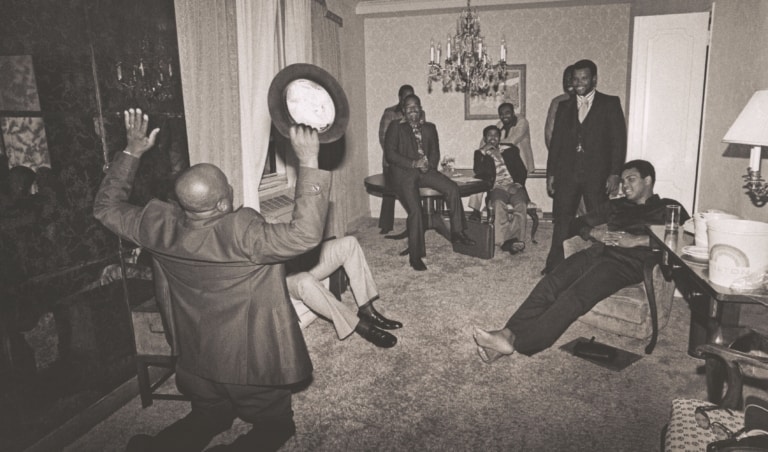
His Corner Team
In the beginning of his career, figures like Alberta Jones, Joe Martin, and Fred Stoner Sr. set Muhammad Ali up for success. Ali simultaneously trained with Martin and Stoner at the beginning of his career, and his early style included influences from both. Angelo Dundee and Drew “Bundini” Brown were stalwart supporters in the ring throughout his professional career, with Bundini originally coining Muhammad’s now iconic phrase “Float Like a Butterfly, Sting Like a Bee.” Ali trained at Dundee’s famous Fifth Street Gym in Miami, Fla., where he mingled with Malcolm X and the Beatles, to name a few.

His Friends in Spirituality
Malcolm X and Muhammad’s lives only overlapped for a few years, but during that time they would form a brotherhood documented around pop culture, including Blood Brothers by Randy Roberts and Johnny Smith. Ali’s friendship with Malcolm would lead him to the Nation of Islam and guide the beginning of his spiritual journey.
The National of Islam provided allies to a young Muhammad Ali, including the Honorable Elijah Muhammad, who gave him the name Muhammad Ali after he announced he would no longer go by Cassius Clay. Elijah Muhammad’s sons Wallace and Herbert would also become close to the Champ, and Herbert would manage Ali intermittently throughout his professional career.

His Friends in Art
Influenced by his father, Cassius Clay, Sr., who was a painter, Muhammad Ali was always drawn towards the arts. Bonds he made with artists would become an important part of how the story of Ali is told, including those with photographer Howard Bingham, and painter LeRoy Neiman, both of whom he met in 1962.
Bingham would become Ali’s personal photographer, traveling the world with the Champ and enjoying unfettered access.
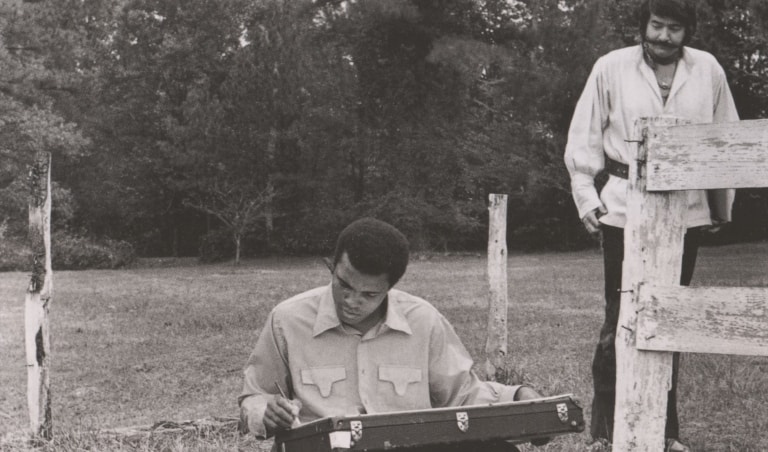
Neiman would attend many Ali fights, painting them by round. Ali and Neiman would send each other art, and many of Muhammad Ali’s original artworks are dedicated to Neiman. The LeRoy Neiman and Howard Bingham Galleries remain an important part of the Muhammad Ali Center to this day.
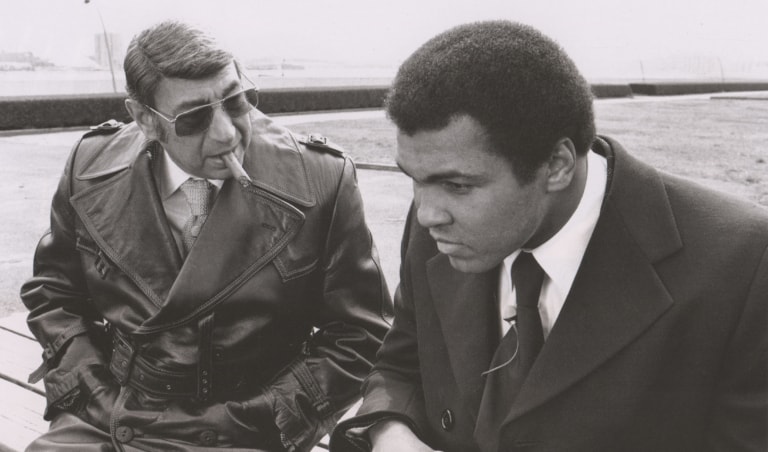
His Bond in the Limelight
Ali enjoyed time with media from around the world, but the bond he built with ABC Sports legend Howard Cosell was unlike any other. Cosell and Ali’s unlikely friendship was built on mutual respect and a shared sense of humor and justice. Dave Kindred wrote about their friendship in his biography of the two, “Sound of Fury.”
"There was nothing traditional about Ali and Cosell. A thimble would have contained their humility with room left over for an elephant."
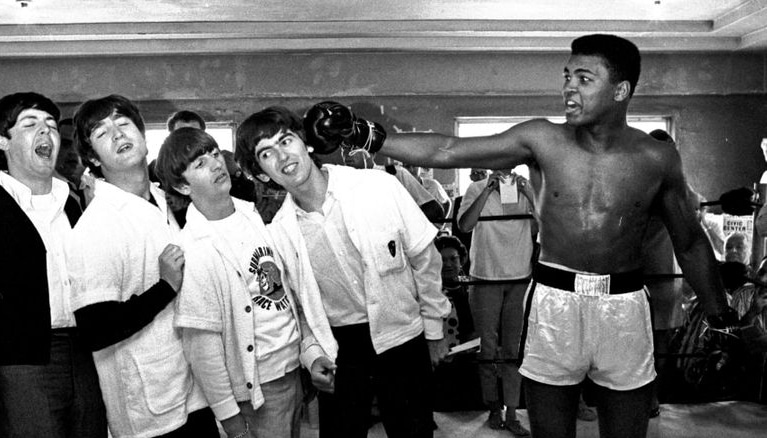
Ali's Friends
Muhammad Ali's fame brought him to many places to meet many people. See some well-known people who met with The Champ.
Shop the Museum
What are you looking for.
- Environment
- Road to Net Zero
- Art & Design
- Film & TV
- Music & On-stage
- Pop Culture
- Fashion & Beauty
- Home & Garden
- Things to do
- Combat Sports
- Horse Racing
- Beyond the Headlines
- Trending Middle East
- Business Extra
- Culture Bites
- Year of Elections
- Pocketful of Dirhams
- Books of My Life
- Iraq: 20 Years On
Muhammad Ali's 1972 journey to Islam and Hajj
Fifty years ago the former heavyweight boxing champion made the pilgrimage to makkah.
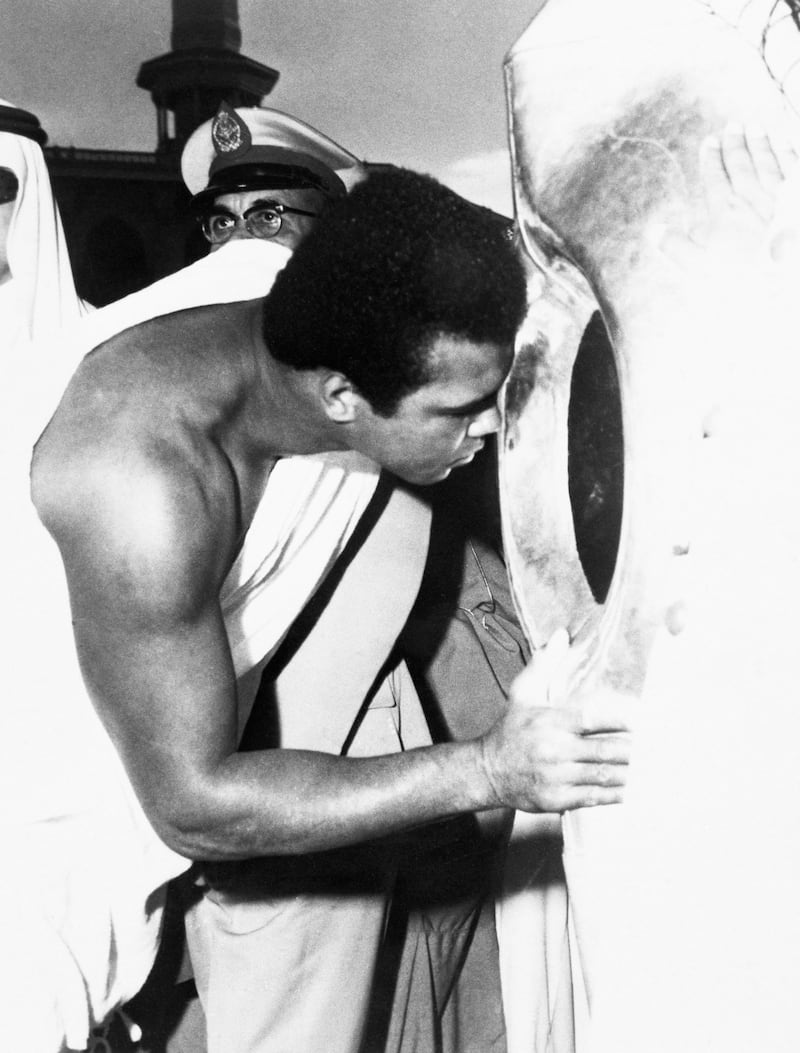
Former world heavyweight boxing champion Muhammad Ali kisses the Black Stone in the Kaaba while performing Hajj in 1972. Getty

Read the latest updates on the Hajj pilgrimage here
There was an unmistakable face among the hundreds of thousands of pilgrims who made the journey to Makkah for Hajj in 1972.
Wearing the simple white cotton robes worn by all men who carry out the pilgrimage was Muhammad Ali . The self-styled greatest heavyweight boxing champion of the world was instantly recognisable, even to those with little interest in the sport.
A photographer was there to capture the moment when Ali bent down to kiss the Black Stone, or Hajar Al Aswad, in the Kaaba.
That image should have represented the high point of Ali’s spiritual journey, the pilgrimage to Makkah that all able Muslims are required to perform and one of the five pillars of Islam.
"I have had many nice moments in my life, but the feelings I had while standing on Mount Arafat on the day of the Hajj was the most unique,” he told Saudi newspaper Al Madinah in 1989.
“I felt exalted by the indescribable spiritual atmosphere as over one and a half million pilgrims invoked God to forgive them for their sins and bestow on them His choicest blessings."
But the branch of Islam the boxer followed at the time was on the far fringes of the religion and his views were regarded as extreme by many Muslims. Within a few years of the pilgrimage, a crisis of belief would lead him to reassess the direction of his faith.
Born into a devout Christian family, the young Ali, who was baptised as Cassius Marcellus Clay Jr, was heavily influenced by his mother. “Momma Bird” Odessa Clay regularly took her son to worship at the King Solomon Missionary Baptist Church in Louisville, Kentucky.
His religious views began to change as a teenager, the result of the racism and segregation he experienced growing up in the southern US state.
Following his own path
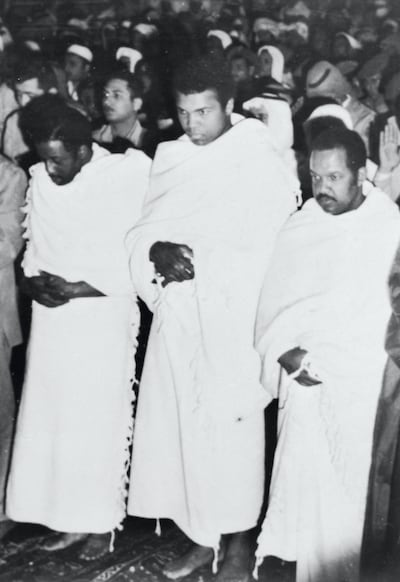
At the age of 16, Ali started down the path to his conversion to Islam. He was influenced by a cartoon in a newspaper published by the Nation of Islam, a religious and political group in the US. The image showed a black Muslim slave being beaten by a white overseer because of his faith.
Ali later wrote to his second wife, Khalilah, that “the thing that attracted me to Islam was a cartoon".
Some months earlier he had taken part in a Golden Gloves tournament in Chicago, buying a record he would play repeatedly. “A White Man’s heaven is a Black Man’s hell” was recorded by a Calypso singer called Louis Farrakhan, a black supremacist who is now the leader of the Nation of Islam.
Ali's anger towards white society in the US came to a head in 1960, when he was 18. He returned in triumph from the Olympic Games in Rome having won the gold medal for boxing in the light heavyweight division.
As a national hero, he believed he would be treated differently. Reality hit him hard when he was turned away from a restaurant in Louisville because of his race. It was reported that he threw his medal into the Ohio River in disgust, saying years later “that was the moment I became a Muslim".
Ali soon left Kentucky, moving to Miami to train for his first title fight and worshipping for the first time at the city’s Al Ansar Mosque, which was run by the Nation of Islam.
His faith was a closely guarded secret at the time owing to fears it could cost him the title fight with Sonny Liston because of prejudice against black Muslims.
Making a name for himself after historic victory
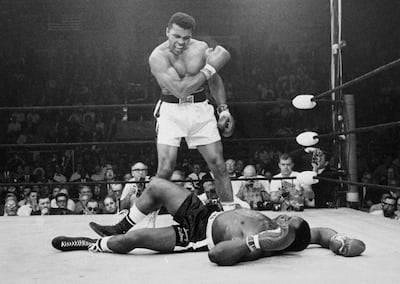
In public, Ali spoke of going to church. On the eve of the fight, in February 1964, it was reported that he prayed. Only a handful of people knew he did so as a Muslim and had been accompanied by American Muslim leader and civil rights figure Malcolm X.
Ali’s defeat of Liston shook the world of boxing, as did his public declaration a day later that he was a Muslim.
He later said Cassius Clay was a slave name. He was named after his father, who ha named after a member of the white Clay family, a committed abolitionist and opponent of slavery in the 19th century.
The boxer's new name honoured Ali, son-in-law of the Prophet Mohammed, with the first name being a tribute to Elijah Muhammad, the leader of the Nation of Islam at the time.
The Nation of Islam was a product of the oppression of black people in the US. It claimed the white race was created to oppress black people by a scientist named Yakub.
It said a space ship would arrive and wipe out life on Earth for a 1,000 years. Ali once claimed he saw the ship during an early morning training run.
Ali expressed the views of the organisation and its charismatic spokesman Malcolm X.
Ali opposed desegregation, going against Christian civil rights activists such as Martin Luther King, and said self-help was the only way forward for black Americans.
He described white people as “blue-eyed, blonde-haired devils".
Ali reigns again before spiritual journey
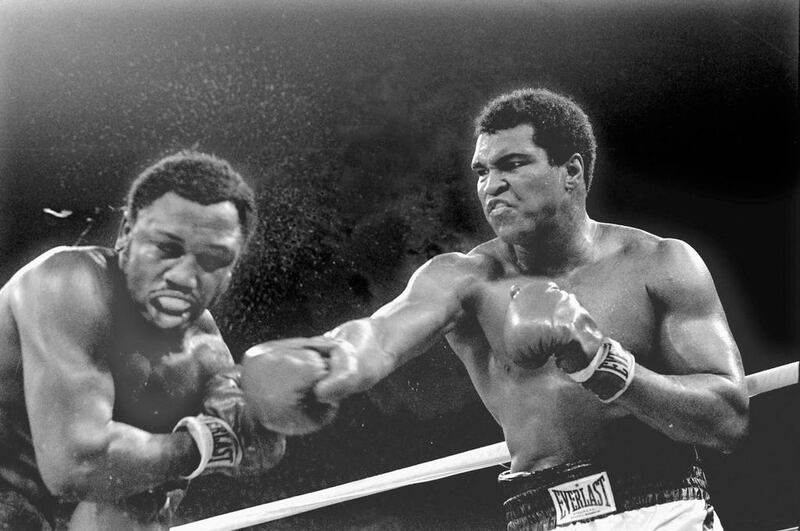
After refusing to be drafted to fight in the Vietnam War on religious grounds, Ali was stripped of his heavyweight title in 1967 and warned he could be jailed.
In 1971, the Supreme Court upheld his status as a conscientious objector and overturned the ruling that he evaded the draft.
His passport, which was taken away with his title, was returned and in January 1972 Ali flew to Makkah to perform Hajj. He also met members of Saudi Arabia's royal family.
By now an admired figure in the Muslim and Arab world, Ali said the experience of visiting the Prophet Mohammed’s tomb in Madinah gave him faith that he could defeat Joe Frazier, who had beaten him a year earlier.
Ali would narrowly win against Frazier in 1974 and go on to reclaim his world title from George Foreman in the “Rumble in the Jungle” in Zaire.
Ali's religious views were beginning to mature. His former mentor, Malcolm X, had split from the Nation of Islam after renouncing its views and was assassinated in 1965 by three members of the organisation.
Malcolm X had become a Sunni after performing Hajj and Ali followed suit in 1975, helped by the death of Elijah Muhammad the same year and the decision of the Nation of Islam to renounce its more extreme views.
Towards the end of his life, and suffering from Parkinson’s disease, Ali revealed in 2004 that he now was drawn to Sufism and later Sunni-Sufi Islam, as well a becoming increasingly tolerant of all faiths.
"Rivers, ponds, lakes and streams – they all are unique, but they all contain water,” he said.
Middle East Today
The must read newsletter for the region

Harmonizing Rebellion: The Journey of Muhammad Ali and George Harrison
Publisher description.
"Harmonizing Rebellion: The Journey of Muhammad Ali and George Harrison": "Harmonizing Rebellion: The Journey of Muhammad Ali and George Harrison" is a fascinating and inspiring book that explores the lives and legacies of two of the most iconic figures of the 20th century. Muhammad Ali, the legendary boxer and social justice activist, and George Harrison, the renowned musician and songwriter, may seem like an unlikely pair, but their journeys share a common thread - a commitment to using their platforms to speak truth to power and fight for a better world. Through their stories, this book delves into the intersection of sports, music, and social justice, highlighting the ways in which both Ali and Harrison used their talents to challenge the status quo and inspire others to do the same. From Ali's refusal to serve in the Vietnam War to Harrison's philanthropic efforts and environmental activism, their lives serve as a testament to the power of courage, conviction, and creativity in driving positive change. Part biography, part social commentary, "Harmonizing Rebellion" is a must-read for anyone interested in the history of social justice movements, the impact of sports and music on culture, and the enduring legacies of two of the most influential figures of our time.
More Books by William K. Robinson

- Literature & Fiction
- Genre Fiction

Enjoy fast, free delivery, exclusive deals, and award-winning movies & TV shows with Prime Try Prime and start saving today with fast, free delivery
Amazon Prime includes:
Fast, FREE Delivery is available to Prime members. To join, select "Try Amazon Prime and start saving today with Fast, FREE Delivery" below the Add to Cart button.
- Cardmembers earn 5% Back at Amazon.com with a Prime Credit Card.
- Unlimited Free Two-Day Delivery
- Streaming of thousands of movies and TV shows with limited ads on Prime Video.
- A Kindle book to borrow for free each month - with no due dates
- Listen to over 2 million songs and hundreds of playlists
- Unlimited photo storage with anywhere access
Important: Your credit card will NOT be charged when you start your free trial or if you cancel during the trial period. If you're happy with Amazon Prime, do nothing. At the end of the free trial, your membership will automatically upgrade to a monthly membership.
Buy new: .savingPriceOverride { color:#CC0C39!important; font-weight: 300!important; } .reinventMobileHeaderPrice { font-weight: 400; } #apex_offerDisplay_mobile_feature_div .reinventPriceSavingsPercentageMargin, #apex_offerDisplay_mobile_feature_div .reinventPricePriceToPayMargin { margin-right: 4px; } $17.00 $ 17 . 00 FREE delivery Thursday, May 16 on orders shipped by Amazon over $35 Ships from: Amazon.com Sold by: Amazon.com
Return this item for free.
Free returns are available for the shipping address you chose. You can return the item for any reason in new and unused condition: no shipping charges
- Go to your orders and start the return
- Select the return method
Save with Used - Acceptable .savingPriceOverride { color:#CC0C39!important; font-weight: 300!important; } .reinventMobileHeaderPrice { font-weight: 400; } #apex_offerDisplay_mobile_feature_div .reinventPriceSavingsPercentageMargin, #apex_offerDisplay_mobile_feature_div .reinventPricePriceToPayMargin { margin-right: 4px; } $13.01 $ 13 . 01 $3.99 delivery May 17 - 21 Ships from: Shakespeare Book House Sold by: Shakespeare Book House

Download the free Kindle app and start reading Kindle books instantly on your smartphone, tablet, or computer - no Kindle device required .
Read instantly on your browser with Kindle for Web.
Using your mobile phone camera - scan the code below and download the Kindle app.

Image Unavailable

- To view this video download Flash Player

Ali and Me: Muhammad Ali, A Joy and My Journey Paperback – December 7, 2022
Purchase options and add-ons.
- Print length 331 pages
- Language English
- Publication date December 7, 2022
- Dimensions 6 x 0.75 x 9 inches
- ISBN-13 979-8367450095
- See all details

Product details
- ASIN : B0BRHDW6L1
- Publisher : Independently published (December 7, 2022)
- Language : English
- Paperback : 331 pages
- ISBN-13 : 979-8367450095
- Item Weight : 15.7 ounces
- Dimensions : 6 x 0.75 x 9 inches
- #3,876 in Biographical Historical Fiction
- #6,508 in Biographical Fiction (Books)
Customer reviews
Customer Reviews, including Product Star Ratings help customers to learn more about the product and decide whether it is the right product for them.
To calculate the overall star rating and percentage breakdown by star, we don’t use a simple average. Instead, our system considers things like how recent a review is and if the reviewer bought the item on Amazon. It also analyzed reviews to verify trustworthiness.
Reviews with images

- Sort reviews by Top reviews Most recent Top reviews
Top reviews from the United States
There was a problem filtering reviews right now. please try again later..
- Amazon Newsletter
- About Amazon
- Accessibility
- Sustainability
- Press Center
- Investor Relations
- Amazon Devices
- Amazon Science
- Sell on Amazon
- Sell apps on Amazon
- Supply to Amazon
- Protect & Build Your Brand
- Become an Affiliate
- Become a Delivery Driver
- Start a Package Delivery Business
- Advertise Your Products
- Self-Publish with Us
- Become an Amazon Hub Partner
- › See More Ways to Make Money
- Amazon Visa
- Amazon Store Card
- Amazon Secured Card
- Amazon Business Card
- Shop with Points
- Credit Card Marketplace
- Reload Your Balance
- Amazon Currency Converter
- Your Account
- Your Orders
- Shipping Rates & Policies
- Amazon Prime
- Returns & Replacements
- Manage Your Content and Devices
- Recalls and Product Safety Alerts
- Conditions of Use
- Privacy Notice
- Consumer Health Data Privacy Disclosure
- Your Ads Privacy Choices

IMAGES
VIDEO
COMMENTS
Muhammad Ali (born January 17, 1942, Louisville, Kentucky, U.S.—died June 3, 2016, Scottsdale, Arizona) was an American professional boxer and social activist. Ali was the first fighter to win the world heavyweight championship on three separate occasions; he successfully defended this title 19 times.
Muhammad Ali was born on January 17, 1942, in Louisville, Kentucky. His birth name was Cassius Marcellus Clay Jr. ... I set out on a journey of love, seeking truth, peace, and understanding. l am ...
Muhammad Ali's Early Years and Amateur Career . Cassius Marcellus Clay Jr., the elder son of Cassius Marcellus Clay Sr. (1912-1990) and Odessa Grady Clay (1917-1994), was born on January 17 ...
Muhammad Ali (/ ɑː ˈ l iː /; born Cassius Marcellus Clay Jr.; January 17, 1942 - June 3, 2016) was an American professional boxer and activist. Nicknamed "the Greatest", he is regarded as one of the most significant sports figures of the 20th century and is often regarded as the greatest heavyweight boxer of all time.He held the Ring magazine heavyweight title from 1964 to 1970.
Within six years, Muhammad Ali had a gold medal hanging around his neck at the Olympic Games in Rome. Muhammad Ali's Olympic medal came at Rome 1960. (Getty Images) 'Turbulent' journey to Rome 1960. Muhammad Ali traveled to the Rome 1960 Olympics to represent the United States as a callow, relatively unknown 18-year-old.
The red Schwinn bike of twelve-year-old Muhammad Ali (then Cassius Clay, Jr.) is stolen outside the annual Louisville Home Show. Reporting the theft to nearby policeman Joe Martin, he expresses a desire to "whup" the culprit. ... Be part of preserving and sharing Muhammad Ali's life journey, supporting today's changemakers, and ...
The Muhammad Ali Center tells the story of Muhammad Ali around the six core principles that defined his life - Confidence, Conviction, Dedication, Giving, Respect and Spirituality. ... Be part of preserving and sharing Muhammad Ali's life journey, supporting today's changemakers, and developing tomorrow's leaders. Donate Now; Become a ...
Muhammad Ali sponsored the Children's Journey for Peace, and was one of the founders of the Children's Peace Foundation. The summer-long peace crusade involved Ali and 50 children from around the globe visiting Moscow, Peking, New Delhi, London, Washington, D.C., and the Vatican, petitioning their leaders to fight for peace by the year 2000.
Muhammad Ali scoops up his baby daughter Maryum and explains a concept that she couldn't possibly understand at such a tender young age: "Your daddy is fighting for you," he is reported as ...
Published: June 4, 2016 8:39pm EDT. Many factors came together to create recognition of Muhammad Ali, who aged 74, as "the greatest" boxer in history. There is no doubt Ali's determination ...
A new documentary on Muhammad Ali by filmmaker Ken Burns reveals a man who stayed true to himself throughout his life and that universal love of the sporting icon didn't come until very late in ...
🥊Muhammad Ali: The Greatest - A Legendary Life's Journey🥊 Embark on a captivating journey through the life of Muhammad Ali, one of the most iconic figures ...
In The Soul of a Butterfly the great champion takes readers on a spiritual journey through the seasons of life, from childhood to the present, and shares the beliefs that have served him well. After fighting some of the fiercest bouts in boxing history against Joe Frazier and George Foreman, today Muhammad Ali faces his most powerful foe ...
This fascinating video chronicles the unforgettable championship journey of legendary boxer Muhammad Ali. Discover the milestones of Ali's career and his tri...
June 2, 2017 4:39 PM EDT. Muhammad Ali 's public conversion to Islam, in 1964, was among the most defining moments of his remarkable life. The decision enraged his critics — his hometown ...
So Muhammad Ali begins this spiritual memoir, his description of the values that have shaped and sustained him and that continue to guide his life. In The Soul of a Butterfly the great champion takes readers on a spiritual journey through the seasons of life, from childhood to the present, and shares the beliefs that have served him well.
Here's a journey through the life and times of the legend. Muhammad Ali, the king of the ring, breathed his last on Saturday after a 30-year battle with Parkinson 's. Arguably the greatest sportsman of our times, Ali's whups inside the ring were matched only by his wit outside.
Ali's father, Cassius Clay, Sr. and mother, Odessa Clay were large influences on his life. His mother played a big part in building up Ali's spirituality and was a big supporter throughout his boxing career. Ali's father worked as a painter and inspired Ali in the arts.Ali's younger brother Rahaman was a lifetime companion.
This photograph journal traced Muhammad Ali's 30 years journey thru life. It started with introductory notes written by the Man himself & his wife (Lonnie Ali), Bill Cosby, Nelson Mandela, Henry Cooper (just to name a few), mainly discussing the bond between the photographer & the man himself, how they percepted the great boxer on & off the limelight.
There was an unmistakable face among the hundreds of thousands of pilgrims who made the journey to Makkah for Hajj in 1972. Wearing the simple white cotton robes worn by all men who carry out the pilgrimage was Muhammad Ali. The self-styled greatest heavyweight boxing champion of the world was instantly recognisable, even to those with little ...
So Muhammad Ali begins this spiritual memoir, his description of the values that have shaped and sustained him and that continue to guide his life. In The Soul of a Butterfly the great champion takes readers on a spiritual journey through the seasons of life, from childhood to the present, and shares the beliefs that have served him well.
"Harmonizing Rebellion: The Journey of Muhammad Ali and George Harrison": "Harmonizing Rebellion: The Journey of Muhammad Ali and George Harrison" is a fascinating and inspiring book that explores the lives and legacies of two of the most iconic figures of the 20th century. Muhammad Ali, the legend…
Paperback. $17.00 1 Used from $13.00 1 New from $17.00. For a decade, I had the startling good fortune to work for Muhammad Ali. Volumes have been written documenting his boxing prowess, social activism, and public antics. This book traces remembrances of times we spent together, his influence on my life, and the journey he set me upon.
140.9K Likes, 809 Comments. TikTok video from ptiqueen (@hoorpti8071): "Explore the inspiring journey of Ali Muhammad Khan, a passionate PTI supporter, MNA, and talented poet. Discover his love for Imran Khan and his impactful work. Join us as we delve into his remarkable story. #imrankhanzindabad #pti_lover".